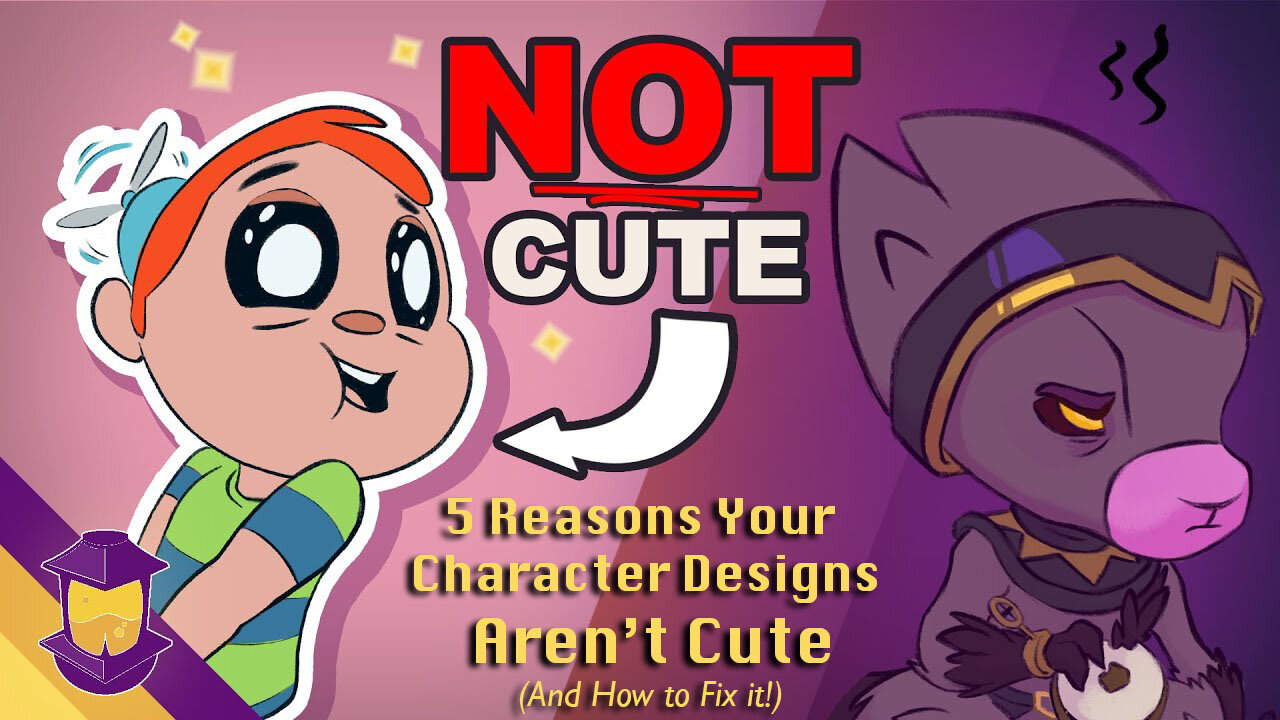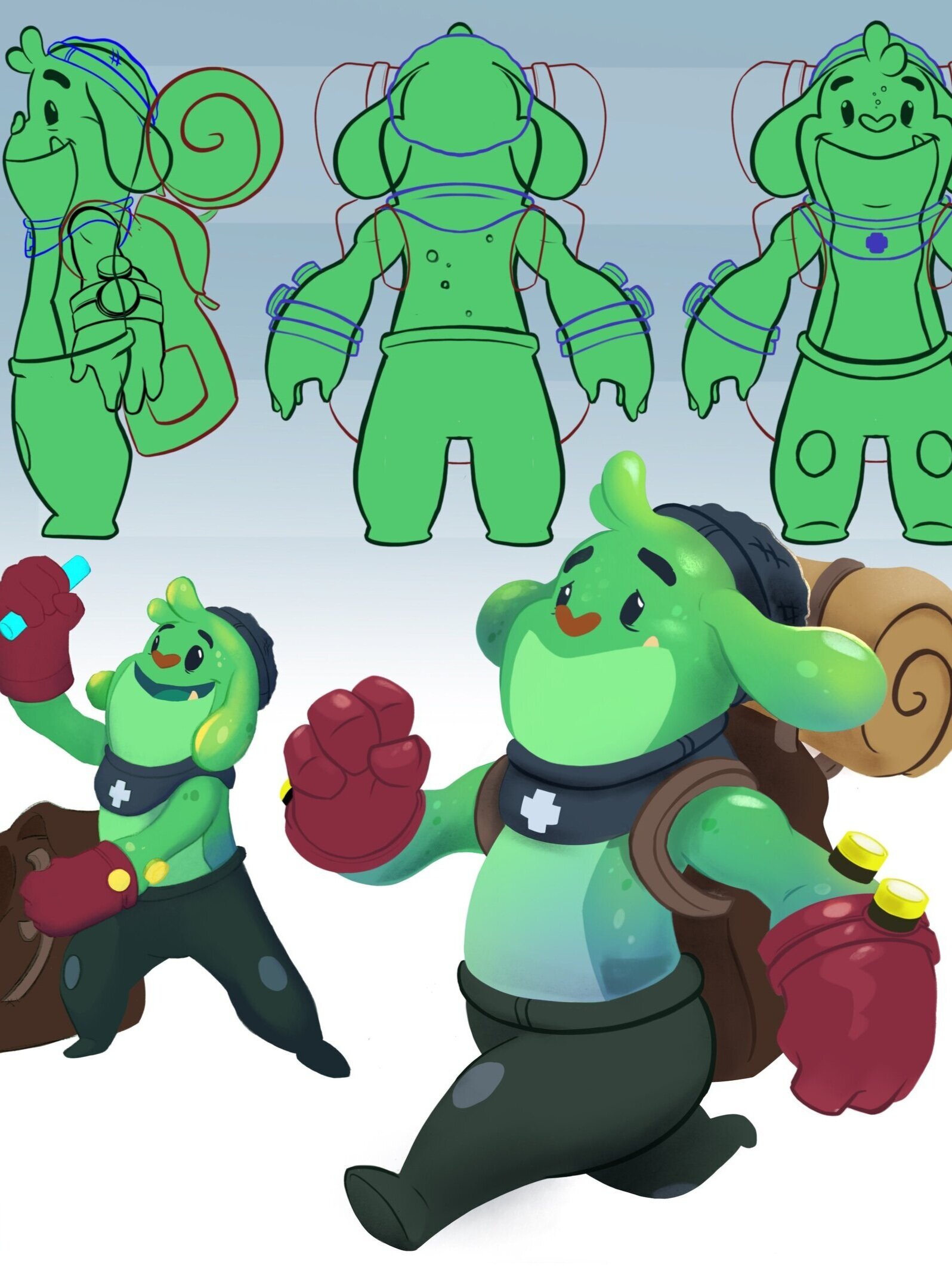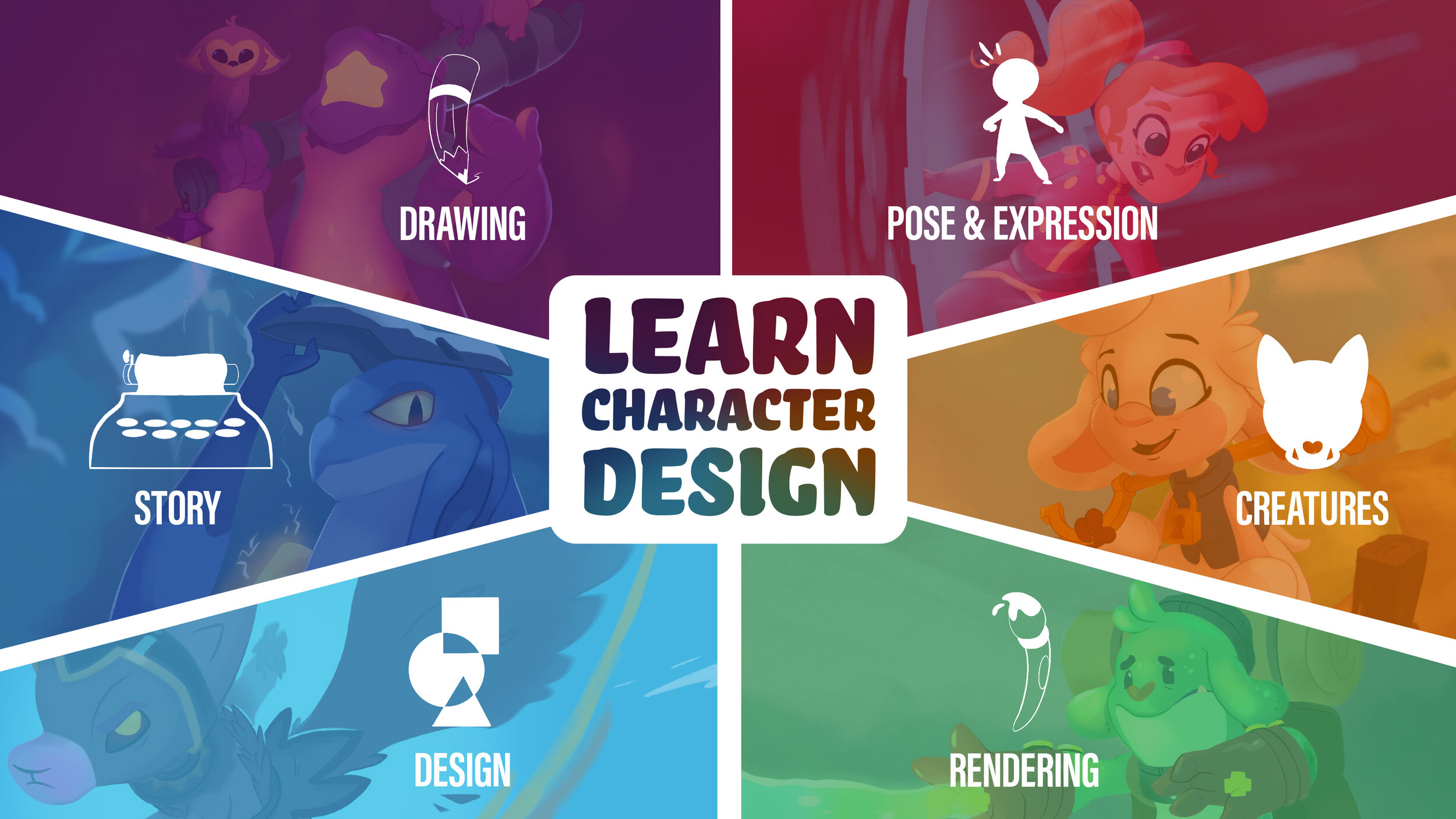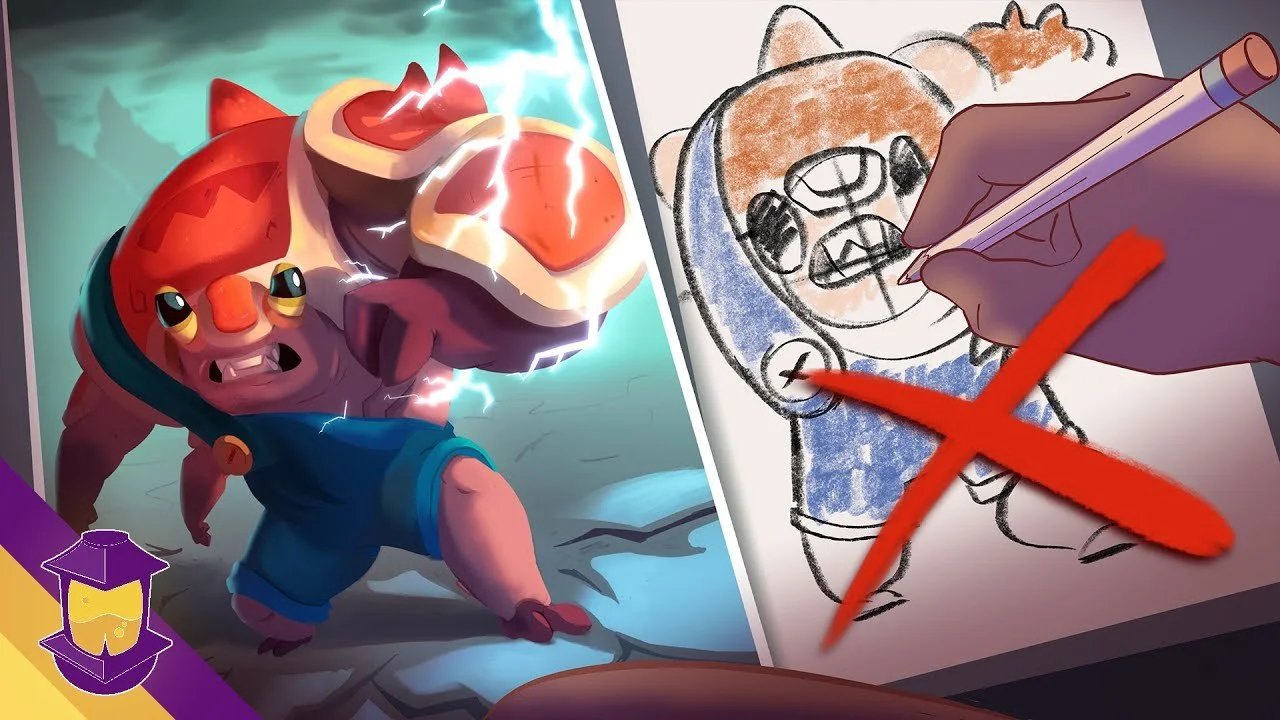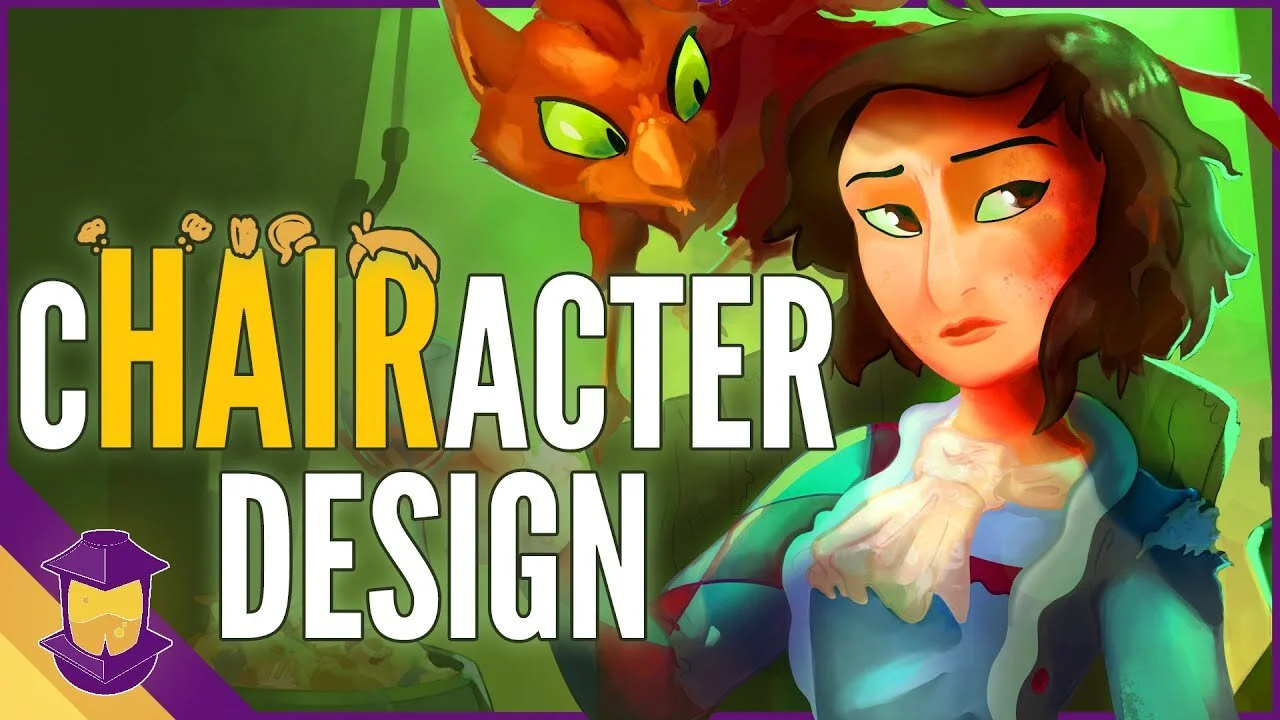Cute Characters.
I’d say how to draw cute characters is the most well-covered ground in character design.
No doubt you’ve heard the same advice over and over: give them the features of a baby. Give them big eyes, give them a big forehead. Make the other features small, make them simplistic.
But does that automatically mean that everyone that applies these ideas get universally successful cute characters? Well, that’s why we’re here today. There are five things that can still prevent your characters from being successfully cute. So let’s fix them.
Watch this video now!
Let’s Talk About Interest
One of the most successful cute character designs in recent history is the Child, Grogu, or “Baby Yoda”, from “The Mandalorian”.
I would say very few disagree with the fact that this is a really charming and endearing character.
Interest has to do with all of the factors that don’t necessarily make our characters cute. In this case, all of the wrinkles and features that make this character look like an elderly person. The white hair, the drooping mouth, even the green skin.
For people that were already Star Wars fans, the idea that this is an offshoot of the Yoda character design makes this character more intriguing.
For a character like Stitch, it can be the sharp teeth, the alien arms, and spikes, and the propensity for evil, or at the very least, mischief.
If your goal was to just create a “cute” character, these are things you’d probably steer away from adding to a design. And yet they’re part of what helps these characters to succeed as good character designs overall!
Interest is a small twist of your character’s cuteness status quo— something that adds an amount of complexity to their visuals or personality.
Let’s Talk About Avoiding Homogeny
(Bear with this comparison, since there is a difference between something being cute, and someone being attractive). But a lot of times, the standards and reasons given for attractiveness have to do with a lack of flaws, a lack of imperfections. The corners being sanded off, as it were. Ah yes, perfect skin, symmetry of the face— boring stuff like that.
(sick of creating characters will all the same perfect face? Here’s a video for you on beating same-face syndrome!)
And yet, here’s the aggregate average of human faces by country from around the world:
Because of the averaging out of the pictures taken, the result is a face that is without flaws or individualistic features.
They are very nice looking, but apart from some distinctive traits like skin color, eye nose, and head shape, these faces are hard to tell apart from each other.
This is relatively nuanced, but the principle of character design this calls upon is contrast. It’s like we’re sanding down our character’s nose to spite their face!
There are principles of character design that contribute to “cute” design language, sure. But if you only follow these things as if they are rules (AKA: you ONLY use round shape language) you’ll end up with designs that are TECHNICALLY CUTE and VISUALLY INOFFENSIVE… aaaaand UNINTERESTING AND HOMOGENOUS.
So let’s recap:
As we talked about with the Child and Stitch: don’t be afraid of using something distinctive.
Instead of operating solely to make something cute, prioritize authentic personality.
Avoid homogeny by developing your own library of features and shapes instead of just borrowing from other artists.
(Are you interested in improving the quality of your character’s expressions? Check out Module 4 “Pose and Expression” in the Learn Character Design Course. It will teach you how to create more interesting and expressive character designs and poses.)
Let’s Talk About Pandering
Speaking of authenticity, the opposite of that is artifice.
I want you to think of two different children, a kid who does something that is genuinely funny- they say something surprising, they’re goofy, or endearing, just by being themselves.
Wi’l Mistah Pwecocious OR genuinely cute kid who is just being a kid?
And now think of a kid who can tell that they’re funny. They act pReCoCiOuS. They say things they think older people will find funny. Maybe they use it to get away with things.
Which one is going to endear you and which is going to repel you?
Now as artists, sometimes the effort put in to make a character’s expression, features, or personality cute easily backfires for this very reason. The lathering on of cuteness at the expense of something real can easily feel to our audience like we are forcing something.
The idea of a character with a sense of “aren’t I so cute?!” can repel more than it endears.
From a practical standpoint, this might mean that the design or subject matter that we start with is unconventional or non traditionally cute, or that we do what we can to again, put dash a bit more spice into that personality beyond that shallow or fleeting top layer.
To put it another way: think about how unpleasant it is to try to swallow a cup of granulated sugar all at once instead of using it as an ingredient in a cake!
For me, I feel like I was eventually successful with the character of Biko, not because my ultimate goal was to make a cute character.
In actuality, earlier versions of the character were uglier and grumpier. But in an effort to make him more relatable to the audience, and so that we can empathize with what he goes through, it felt right to simplify some of his features.
The result is something that has some of the literal and metaphorical tooth of the original. And nothing about the character is defined by appealing visuals. He’s just a guy going about his job.
Let’s Talk About “Uncanny”
This next reason is purely technical and is often the result of limited skill. The uncanny valley is when something’s resemblance to something human or relatable leaves the boundaries of belief.
This usually happens because the amount of realism or level of detail given to a character has become too contradictory to the abstraction that a character has.
In the other direction, though, a lack of technical skill or experience can cause a design to look lifeless, soulless, or have an imbalance in detail.
A mistake in construction or perspective can break the illusion of depth, just as well, an uncanny mistake in a character can break the illusion of life.
There is little more disturbing on this earth than the bootleg paintings of Disney characters on the side of daycares, and that’s a prime example of why experience and skill make all the difference, especially when the character is trying to make an appeal to the viewer.
Let’s Talk About Purpose
Second to last point (and perhaps a lesser one) is a LACK of purpose or function. A series that succeeds greatly because of the cuteness of its characters is Animal Crossing.
And I think that within the game, the cuteness of a character is both a docile aesthetic AND a non-threatening function.
This is a game meant for escapism to a degree, and the interaction that you have with the characters is mainly through dialogue and expression. Already the proportions of the characters contribute to a cute look because of that, and the overall average of cuteness is high within the game.
However, by no means is every character necessarily cute. As long as the series has been around, the Animals aren’t always docile towards you either. That’s changed a bit recently. There are enough odd-looking, plain-looking, quirky villagers in Animal Crossing that, if your goal is to ONLY collect some aesthetically good ones, you might have to let a few move out.
There are some jarring, even creepy looking villagers, especially in the hamster family.
Pietro the clown sheep was in my wife Tay’s village. The first thing he said to her was “How nice she smelled!” and he teleported around the island. He did not last long.
Remember that a lot of what we do with a character that is cute, just like we would with a child or puppy, is projection— imbuing something that is simple and charming with what we want to see.
And while the characters have a certain amount of stock personality, you are left to project on to them with given gifts, catchphrases, and inferences to develop them into a digital person you know. Or just develop an irrational hatred of, like, Charlise the bear.
The point is that all of these factors make a really good case for why the characters look the way they do, specifically, cute simplified abstractions.
Key Point to Keep in Mind:
Just the same as you would when making any art decisions around style or otherwise, figure out why your characters need to be cute and to what degree it will benefit the story to make them so. Again, we want to move beyond them being a tacked-on artifice, and instead give them real purpose.
(Not sure how to make characters your audience will actually care about, cuteness aside? Watch this video on How to Make Characters People Care About)
Let’s Talk About Lack of Appeal
Something I’ve driven home a lot at the Forge has to do with what my personal definition of “Appeal” is— beyond something just being “appealing”.
(Discover what Appeal looks like in popular designs amongst Disney, Pixar, and otherwise in my video series, “How to Design Appealing Characters Part I”)
I tend to find that the motion and lines within a design unifying and working together, solving multiple problems with one solution, leads to good appeal.
For example, the beautiful new Crash Bandicoot design (done by my friend Nicholas Kole), solves multiple problems in the geometry of the head and moves in a particular direction, instead of allowing each disparate element to feel tacked on.
Now if we took all those rules and principles of cute characters, big eyes, big head, small features, but didn’t apply any appeal, you’d get the majority of the human sculpts for Funko Pop figures.
All the elements are there, and you may not agree with me, but this is not cute or appealing. Beyond the eyes being soulless, there is no unity between the features.
Another example that I will see in beginner or amateur art is a change to a character’s eye shape, whether neutral or in an expression, that breaks the appeal of a face.
Concave lines under the eyes, as demonstrated above with my character Jacqueline, not only defy what’s plausible in expression but now throws off where those lines are pointing.
If and when you do something like this, make sure to retain some of the lines or shapes that might help this situation, in this case, the impression of the lower eyelid, as seen in the last picture above.
I use the eye as an example because they’re about 90% responsible for our success, but the same idea applies to other features as well.
We talk about appeal and cuteness and good character design overall in my course Learn Character Design. And make sure you’re following over on Instagram @bageldenizen, we’ve been sharing a lot there recently.
Now, I want to hear from you. What do you find makes for a successful “cute” character design? Let me know in the comments section below! Thanks for reading, and have fun creating!
Do you Want to Master your Digital Art and Character Design Skills?
You Can Do it in Just Six Steps
Hey! I’m Brookes Eggleston…
If you’re new here, welcome! I’ve worked in studio settings and in a freelance capacity as a Character Designer, Illustrator, Story Artist, and 3D Modeler for nearly 15 years. But what I love as much as drawing characters is sharing what I’ve learned. Get to know my mission here at Character Design Forge.

